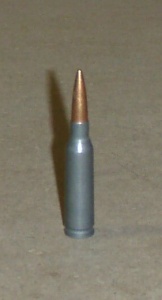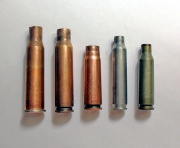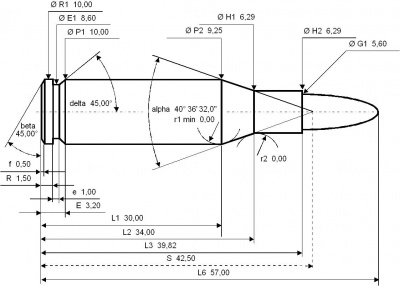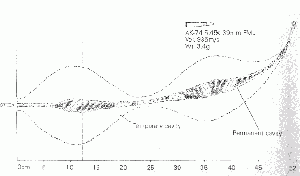Difference between revisions of "5.45x39mm"
(→References) |
(→Enhanced penetration cartridges) |
||
| Line 115: | Line 115: | ||
In 1994 the 7N10 design was improved by filling the remaining hollow cavity in the projectiles front with lead and reducing the weight of the penetrator to 1.72 g (26.5 gr) resulting in a bullet weighing 3.62 g (55.9 gr). Upon impacting a hard target, soft lead is pressed sideways by the steel penetrator, tearing the jacket. | In 1994 the 7N10 design was improved by filling the remaining hollow cavity in the projectiles front with lead and reducing the weight of the penetrator to 1.72 g (26.5 gr) resulting in a bullet weighing 3.62 g (55.9 gr). Upon impacting a hard target, soft lead is pressed sideways by the steel penetrator, tearing the jacket. | ||
| − | The 7N10 cartridge replaced the previous variants as standard Russian service round and can penetrate a 16 mm thick St3 steel plate at 100 m and 6Zh85T body armour at 200 m. | + | The 7N10 cartridge replaced the previous variants as standard Russian service round and can penetrate a 16 mm thick St3 steel plate at 100 m and 6Zh85T body armour at 200 m.<ref name="Evolution of the 5.45 mm bullet">{{cite web|url=http://grigorew.narod.ru/raznoe/kal545.htm|title=Evolution of the 5.45 mm bullet}} (in Russian)</ref> 7N10 bullets have a violet/purple identification ring above the cartridge neck. The 7N10 and 7N6(M) cartridges have practically identical external ballistic characteristics, meaning they can share identical sighting lines and optics on firearms.<ref>{{cite web|url=http://gunsru.ru/rg_patron_5_45x39_eng.html|title=5.45x39 submachine gun cartridges}}</ref> |
The '''7N22''' armour-piercing bullet, introduced in 1998, has a 1.75 g (27.0 gr) sharp-pointed steel penetrator made of steel U12A and retains the soft lead plug in the nose for jacket discarding. 7N22 boat-tail bullets weigh 3.69 g (56.9 gr) and can be identified by their red identification ring above the cartridge neck and a black tip.<ref name="Evolution of the 5.45 mm bullet"/> | The '''7N22''' armour-piercing bullet, introduced in 1998, has a 1.75 g (27.0 gr) sharp-pointed steel penetrator made of steel U12A and retains the soft lead plug in the nose for jacket discarding. 7N22 boat-tail bullets weigh 3.69 g (56.9 gr) and can be identified by their red identification ring above the cartridge neck and a black tip.<ref name="Evolution of the 5.45 mm bullet"/> | ||
Revision as of 12:03, 24 July 2015
| 5.45x39mm Cartridge | 5.45x39mm Ballistics tables | Cartridges |
| 5.45x39mm M74 | ||||||||||
|---|---|---|---|---|---|---|---|---|---|---|

| ||||||||||
| The 5.45 Soviet cartridge. | ||||||||||
| Type | rifle | |||||||||
| Country of Origin | USSR | |||||||||
| Specifications | ||||||||||
| Case Type | Steel, rimless, bottleneck | |||||||||
| Bullet Ø | 5.680 mm (0.2236 in) | |||||||||
| Neck Ø | 6.248 mm (0.2460 in) | |||||||||
| Shoulder Ø | 7.290 mm (0.2870 in) | |||||||||
| Base Ø | 10.033 mm (0.3950 in) | |||||||||
| Rim Ø | 10.008 mm (0.3940 in) | |||||||||
| Rim Thickness | 1.372 mm (0.0540 in) | |||||||||
| Case Length | 39.624 mm (1.5600 in) | |||||||||
| Full Length | 56.388 mm (2.2200 in) | |||||||||
| Primer | Berdan, small rifle | |||||||||
| Production & Service | ||||||||||
| In Service | 1974-present | |||||||||
| Used By | Soviet Union/Russian Federation, former Soviet republics | |||||||||
| Wars | Afghan War (Soviet), Georgian Civil War, First Chechen War, Second Chechen War, Balkan Wars | |||||||||
| Ballistic Performance Sampling | ||||||||||
| ||||||||||
The Soviet 5.45x39mm round was introduced into service in 1974 for the AKS-74U and the AK-74 assault rifle. It gradually supplemented then largely replaced the 7.62x39mm round then in service.
Contents |
History

The 5.45×39mm cartridge was developed in the early 1970s by a group of Soviet designers and engineers under the direction of M. Sabelnikov. Further group members were: L. I. Bulavsky, B. B. Semin, M. E. Fedorov, P. F. Sazonov, V. Volkov, V. A. Nikolaev, E. E. Zimin and P. S. Korolev.
The 5.45×39mm is an example of an international tendency towards relatively small-sized, lightweight, high-velocity military service cartridges. Cartridges like the 5.45×39mm, 5.56×45mm NATO and Chinese 5.8×42mm allow a soldier to carry more ammunition for the same weight compared to their larger and heavier predecessor cartridges and produce relatively low bolt thrust and free recoil impulse, favouring lightweight arms design and automatic fire accuracy.[1]
The Soviet original military issue 7N6 cartridge variant introduced in 1974 are loaded with full metal jacket bullets that have a somewhat complex construction. The 3.43 g (52.9 gr) boat-tail projectile's jacket is clad in gilding metal. The unhardened 1.43 g (22.1 gr) steel (steel 10) rod penetrator core is covered by a thin lead inlay which does not fill the entire point end, leaving a hollow cavity inside the nose. The bullet is cut to length during the manufacturing process to give the correct weight. The 7N6 uses a boat-tail design to reduce drag and there is a small lead plug crimped in place in the base of the bullet. The lead plug, in combination with the air space at the point of the bullet, has the effect of moving the bullet's center of gravity to the rear; the hollow air space also makes the bullet's point prone to deformation when the bullet strikes anything solid, inducing yaw. The brown-lacquered steel case is Berdan primed. Its 39.37 mm (1.55 in) length makes it slightly longer than the 7.62×39mm case which measures exactly 38.60 mm (1.52 in). The primer has a copper cup and is sealed with a heavy red lacquer. The propellant charge is a ball powder with similar burning characteristics to the WC844 powder used in 5.56×45mm NATO ammunition. The 7N6 cartridge weight is 10.75 g (165.9 gr).
Tests indicate the free recoil energy delivered by the 5.45×39mm AK-74 assault rifle is 3.39 J (2.50 ft·lb), compared to 6.44 J (4.75 ft·lb) delivered by the 5.56×45mm NATO in the M16 assault rifle and 7.19 J (5.30 ft·lb) delivered by the 7.62×39mm in the AKM assault rifle.[2]
Military 5.45×39mm ammunition was produced in the former Soviet Union, GDR and Yugoslavia, and is produced in Bulgaria, Poland and Romania. In the former Soviet Union this ammunition is produced in Russia, Kyrgyzstan, Uzbekistan and Ukraine.
Design
The Russian military issue 5N7-specification 5.45 mm bullets are a somewhat complex full metal jacket design. The bullet's core consists mainly of a length of soft steel rod, cut to length during the manufacturing process to give the correct weight. There is a hollow air space ahead of the steel rod behind the bullet tip. The base of the bullet is tapered to reduce drag (a boat-tail bullet) and there is a small lead plug crimped in place in the base of the bullet. The lead plug, in combination with the air space at the point of the bullet, has the effect of moving the bullet's center of gravity to the rear; the hollow air space also makes the bullet's point prone to deformation when the bullet strikes anything solid, inducing yaw.
Specifications
The 5.45×39mm has 1.75 ml (27 grains H2O cartridge case capacity.
5.45×39mm maximum C.I.P. cartridge dimensions.[3]
Americans would define the shoulder angle at α⁄2 ≈ 20.3°. The common rifling twist rate for this cartridge is 255 mm (1 in 10 inches), 4 grooves, Ø lands = 5.40 mm, Ø grooves = 5.60 mm, land width = 2.60 mm and the primer type is either berdan or small rifle.
According to the official C.I.P. (Commission Internationale Permanente pour l'Epreuve des Armes à Feu Portatives) rulings the 5.45×39mm can handle up to 380.00 MPa (55,114 psi) Pmax piezo pressure. In C.I.P. regulated countries every rifle cartridge combo has to be proofed at 125% of this maximum C.I.P. pressure to certify for sale to consumers.This means that 5.45×39mm chambered arms in C.I.P. regulated countries are currently (2014) proof tested at 475.00 MPa (68,893 psi) PE piezo pressure.[3]
Wounding effects
Early ballistics tests done demonstrated a pronounced tumbling effect with high speed cameras.[4] Some Western authorities believed this bullet was designed to tumble in flesh to increase wounding potential.
At the time, it was believed that yawing and cavitation of projectiles was primarily responsible for tissue damage. Non-Soviet alarmists feared that this new cartridge had achieved wounding parity with the 5.56x45mm NATO round. To dispute this, Martin Fackler conducted a study using live pigs and ballistic gelatin demonstrating that the 5.45 mm round does not reliably fragment or cause unusual amounts of tissue disruption. [5] Most organs and tissue were too flexible to be severely damaged by the temporary cavity effect caused by yaw and cavitation of a projectile. With the 5.45 mm bullet, tumbling produced a temporary cavity twice, at depths of 100 and 400 mm. This is comparable to modern 7.62x39mm ammunition and to (non-fragmenting) 5.56 mm ammunition. The average width of a human trunk is 400 mm.
Military 5.45×39mm rounds offer better penetration over (fragmenting) military 5.56×45mm NATO rounds.[6][7] However, unlike its 5.56mm counterpart, the 5.45mm round “does not deform or fragment when striking soft tissues.”[6][7] Nevertheless, during the Soviet Afghan war the Mujahedeen called the 5.45×39mm round the "Poison Bullet" due to the severe wounds it was reputed to produce to extremities and the resulting need to amputate.[8][9][10]
Anti-armor effect
As body armor saw increasing use in Western military forces, bullet construction was changed several times to keep it up with improving means of ballistic protection. In 1987 a steel rod of original design 7N6 bullets was hardened to 60 HRC. In 1992 size of the steel penetrator was increased, and lead plug in front of it discarded (still there was some empty space under the jacket in the bullet's nose), this bullet designated as 7N10 "improved penetration". In 1994 the 7N10 design was improved by filling nasal empty space with lead again. At the impact at hard target soft lead is pressed sideways by following steel penetrator, its hydrostatic pressure tearing the jacket, so the penetrator goes in clear of jacket, being able to penetrate more. In 1998 a new design was introduced - a 7N22 armour-piercing bullet with sharp-pointed steel penetrator made of special steel, still with soft lead plug in the nose for jacket discarding. [11] A newest known design is 7N24 "super-armor-piercing" bullet with penetrator made of tungsten carbide, but due to higher cost it's doubtful that 7N24 would be fielded in large scale.
5.45×39mm cartridge variants
Enhanced penetration cartridges
As body armor saw increasing use in militaries, the original 7N6 standard service cartridge bullet construction was changed several times to improve penetration. This resulted in the 7N6M, 7N10, 7N22 and 7N24 variants.
The 7N6M (M—Russian: Модернизированный; Modernizirovanniy or "modernized") cartridge was introduced in 1987. In contrast to the original 7N6 unhardened steel rod penetrator the 7N6M rod penetrator is made of steel 65 and hardened to 60 HRC. The 7N6M 3.43 g (52.9 gr) boat-tail bullet can penetrate a 6 mm thick St3 steel plate at 300 m and 6Zh85T body armour at 80 m. 7N6(M) bullets have a red identification ring above the cartridge neck.
The US Army's Ballistic Research Laboratory measured a ballistic coefficient (G7 BC) of 0.168 and form factor (G7 i) of 0.929 for the 7N6(M) projectile, which indicates good aerodynamic efficiency and external ballistic performance for the bullet diameter.[12][13]
The Bureau of Alcohol, Tobacco, Firearms and Explosives classified the 7N6 cartridge as "armor piercing handgun ammunition" on 7 April 2014, and, as such, it is illegal to import from Russia to the United States.[14]
The 7N10 "improved penetration" cartridge was introduced in 1992. The 7N10 boat-tail bullet weighs 3.60 g (55.6 gr) and the weight of the lengthened sleeker steel (high-carbon steel U12A) penetrator made of steel 70 was increased to 1.80 g (27.8 gr) and the lead plug in front of it was discarded. The hollow cavity at the front of these projectiles was reduced significantly compared to previous 7N6(M) projectiles.
In 1994 the 7N10 design was improved by filling the remaining hollow cavity in the projectiles front with lead and reducing the weight of the penetrator to 1.72 g (26.5 gr) resulting in a bullet weighing 3.62 g (55.9 gr). Upon impacting a hard target, soft lead is pressed sideways by the steel penetrator, tearing the jacket.
The 7N10 cartridge replaced the previous variants as standard Russian service round and can penetrate a 16 mm thick St3 steel plate at 100 m and 6Zh85T body armour at 200 m.[15] 7N10 bullets have a violet/purple identification ring above the cartridge neck. The 7N10 and 7N6(M) cartridges have practically identical external ballistic characteristics, meaning they can share identical sighting lines and optics on firearms.[16]
The 7N22 armour-piercing bullet, introduced in 1998, has a 1.75 g (27.0 gr) sharp-pointed steel penetrator made of steel U12A and retains the soft lead plug in the nose for jacket discarding. 7N22 boat-tail bullets weigh 3.69 g (56.9 gr) and can be identified by their red identification ring above the cartridge neck and a black tip.[15]
The 7N24 "super-armor-piercing" cartridge, introduced in 1999, has a stub cone nosed penetrator made of tungsten carbide (hard alloy VK8). The 7N24 round is loaded with a 4.15 g (64.0 gr) projectile containing a 2.1 g (32.4 gr) penetrator which is fired with a muzzle velocity of 840 m/s (2,756 ft/s) yielding 1,464 J (1,080 ft·lbf) muzzle energy. 7N24 bullets have a black identification ring above the cartridge neck.
Tracer cartridges
Besides that the tracer cartridges 7T3 and 7T3M were developed. These bullets can be identified by their green marked tips. The 3.23 g (50 gr) tracer projectile has a shorter ogival profile and for 7T3 ammunition burns out to 800 m (870 yd) and for 7T3M ammunition ignites at 50 m (55 yd) burning out to 850 m (930 yd).
Training and instruction cartridges
For training purposes the blank cartridges 7H3, 7H3M and 7Kh3 were developed. These rounds have a hollow white plastic imitation projectile. When these training rounds are used, the barrel of the gun is fitted at the muzzle with a Blank Fire Adapter to produce a gas pressure build-up for cycling the gun, as well as a breakup aid for their plastic projectiles.[17]
For instruction purposes the 7H4 training or dummy cartridge (which has longitudinal grooves) was developed.
Special purpose cartridges
For special purposes the 7U1 subsonic cartridge with a black and green painted meplat and CAP cartridge for underwater were developed.
The 7U1 subsonic cartridge weight is 11 g (170 gr) and is loaded with a 5.2 g (80 gr) projectile which is fired with a muzzle velocity of 303 m/s (994 ft/s) yielding 239 J (176 ft·lbf) muzzle energy. Accuracy of fire at 100 m (109 yd) (R50) is 35 mm (1.4 in).
Basic specifications
| Cartridge designation | 7N6M | 7N10 | 7N22 | 7N24 | 7T3 (tracer) | 7Kh3 (training) |
|---|---|---|---|---|---|---|
| Cartridge weight | 10.5 g (162 gr) | 10.7 g (165 gr) | 10.75 g (166 gr) | 11.20 g (173 gr) | 10.3 g (159 gr) | 6.65 g (103 gr) |
| Bullet weight | 3.43 g (52.9 gr) | 3.62 g (55.9 gr) | 3.69 g (56.9 gr) | 4.15 g (64.0 gr) | 3.23 g (49.8 gr) | 0.24 g (3.7 gr) |
| Muzzle velocity | 880 m/s (2,887 ft/s) | 880 m/s (2,887 ft/s) | 890 m/s (2,920 ft/s) | 840 m/s (2,756 ft/s) | 883 m/s (2,897 ft/s) | |
| Muzzle energy | 1,328 J (979 ft·lbf) | 1,402 J (1,034 ft·lbf) | 1,461 J (1,078 ft·lbf) | 1,464 J (1,080 ft·lbf) | 1,259 J (929 ft·lbf) | |
| Accuracy of fire at300 m (328 yd) (R50) | 75 mm (3.0 in) | 90 mm (3.5 in) | 90 mm (3.5 in) | 96 mm (3.8 in) | 140 mm (5.5 in) |
- R50 at 300 m (328 yd) means the closest 50 percent of the shot group will all be within a circle of the mentioned diameter at 300 m (328 yd).
- The twist rate used in the AK-74M assault rifle that has been adopted as the new service rifle of the Russian Federation in 1991 is 200 mm (7.87 in).
References
- ↑ Assault Rifles and Their Ammunition: History and Prospects by Anthony G. Williams
- ↑ The Russians are coming! The Russians are coming! Or maybe the Polish by Holt Bodinson, Guns Magazine / Sept, 2008
- ↑ 3.0 3.1 C.I.P. TDCC sheet 5,45 x 39
- ↑ Terminal ballistics of the Russian AK 74 assault rifle: Two wounded patients and experimental findings
- ↑ Wounding Potential of the AK-74 Assault Rifle
- ↑ 6.0 6.1 http://www.frfrogspad.com/terminal2.htm | Military rifle bullet wound patterns comparison charts – by Martin L. Fackler.
- ↑ 7.0 7.1 http://ammo.ar15.com/project/Fackler_Articles/ak74_wounding_potential.pdf Wounding Potential of the Russian AK-74 Assault Rifle. Martin L. Fackler MD. John S. Surinchak MA. John A. Malinowski BS. & Robert E. Bowin. The Journal of Trauma 1984. The Williams & Wilkins Co. Vol. 24, No. 3
- ↑ The Gun Digest Book of the AK & SKS: A Complete Guide to Guns, Gear and Ammunition. By Patrick Sweeney. Gun Digest Books, 2009. page 104-105
- ↑ Gun Digest Book of The Tactical Rifle: A User's Guide. By Patrick Sweeney. Krause Publications, 2011. page 151
- ↑ http://www.atncorp.com/night-vision-reviews/SPEC-WEAPONS-09-PS23-CGT.pdf Tandal AK-74S 5.45mm Bringing the AK into the 21st century with modular capability! By Charlie Cutshaw Photos by Doug Richardson. SPECIAL WEAPONS 2009. page 32-37
- ↑ Evolution of the 5,45 mm bullet
- ↑ The Case for a General-Purpose Rifle and Machine Gun Cartridge (GPC) by Anthony G Williams
- ↑ Form Factors: A Useful Analysis Tool by Bryan Litz, Chief Ballistician Berger Bullets
- ↑ Test, Examination and Classification of 7N6 5.45x39 Ammunition ATF Special Advisory at www.atf.gov
- ↑ 15.0 15.1 "Evolution of the 5.45 mm bullet".. (in Russian)
- ↑ "5.45x39 submachine gun cartridges"..
- ↑ Russian 5.45x39mm Assault Rifle Rounds, Land Forces Weapons Export Catalog, page 86

